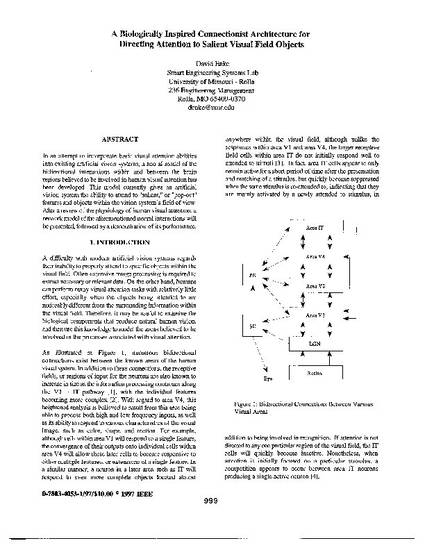
Article
A Biologically Inspired Connectionist Architecture for Directing Attention to Salient Visual Field Objects
Proceedings of the 1997 IEEE International Conference on Systems, Man, and Cybernetics, 1997
Abstract
In an attempt to incorporate basic visual attention abilities into existing artificial vision systems, a neural model of the bidirectional interactions within and between the brain regions believed to be involved in human visual attention has been developed. This model currently gives an artificial vision system the ability to attend to salient, or pop-out features and objects within the vision system''s field of view. After a review of the physiology of human visual attention, a network model of the aforementioned neural interactions is presented, followed by a demonstration of its performance.
Meeting Name
1997 IEEE International Conference on Systems, Man, and Cybernetics, 1997
Department(s)
Engineering Management and Systems Engineering
Keywords and Phrases
- Attention,
- Bidirectional Interactions,
- Computer Vision,
- Machine Vision,
- Neural Model,
- Neural Net Architecture,
- Physiological Models,
- Salient Visual Field Objects
Document Type
Article - Conference proceedings
Document Version
Final Version
File Type
text
Language(s)
English
Rights
© 1997 Institute of Electrical and Electronics Engineers (IEEE), All rights reserved.
Publication Date
1-1-1997
Publication Date
01 Jan 1997
Citation Information
David Lee Enke. "A Biologically Inspired Connectionist Architecture for Directing Attention to Salient Visual Field Objects" Proceedings of the 1997 IEEE International Conference on Systems, Man, and Cybernetics, 1997 (1997) Available at: http://works.bepress.com/david-enke/9/
